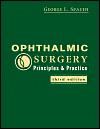Ophthalmic Surgery: Principles and Practice
SYNOPSIS
New edition of a text that introduces surgical techniques to residents and
provides a reference for experienced practitioners with a broad- based
practice. The 66 contributions cover principles of ophthalmic surgery,
cataract, cornea, glaucoma, oculoplastic and vitreoretinal surgery, oncology,
and trauma, as well as new information on laser treatment. Generously
illustrated with b&w images and drawings. Edited by George L. Spaeth, director
of the Williams & Anna Goldberg Glaucoma Service and Research Laboratories.
Annotation c. Book News, Inc., Portland, OR
FROM THE CRITICS
Doody Review Services
Reviewer: Michael Rizen, M.D., Ph.D. (Johns Hopkins Hospital)
Description: This book presents a core body of information that can serve as
the basis for future learning by all ophthalmic surgeons. It covers the major
surgical categories and includes discussions of preoperative care, surgical
technique, and postoperative management for each procedure. This third edition
is a revision and update of the second edition, which was published in 1990.
Purpose: According to the author, the book is intended to provide a core of
information to the comprehensive ophthalmologist and the subspecialist. The
goal is to provide what needs to be known rather than everything that is known
about a given topic. Given the vast amount of available information about
ophthalmic surgery, a book such as this, which extracts the most useful and
clinically relevant material, is indeed valuable.
Audience: The book is written for both the comprehensive ophthalmologist and
the subspecialist. However, it could just as easily serve as a reference for
the ophthalmologist in training. The author is a respected glaucoma expert from
the Wills Eye Hospital and is indeed a credible authority on matters pertaining
to ophthalmic surgery.
Features: All of the major surgical areas are covered, including
orbital/plastic, strabismus, cornea/refractive, cataract, glaucoma, and
vitreoretinal. Within each category, the major procedures are covered in
detail, with diagrams and photographs where appropriate. Special attention is
given to updates or modernization of older procedures (e.g., the trend toward
clear corneal cataract surgery and away from planned extracapsularprocedures).
Glaucoma is particularly well covered, with detailed discussions on the
indications for surgery, the choice of surgery for the individual patient, and
postoperative management, including suture release or lysis. Trauma and repair
of traumatic injuries are less well covered and this chapter could use some
enhancement.
Assessment: This is a concise yet complete compilation of the major surgical
procedures to be mastered by all ophthalmic surgeons. It is sufficiently
detailed to provide a working knowledge of the various procedures, yet not so
detailed that it is cumbersome or difficult to read. It incorporates the latest
surgical technologies and innovations and therefore represents a significant
update since the publication of the prior edition nearly 13 years ago.
Experienced surgeons will find it a useful review of both established and
cutting-edge techniques, while surgeons-in-training will find it a useful
reference and starting point on which to build their surgical knowledge base.
Ophthalmic Surgery: Principles and Practice
TABLE OF CONTENTS
Sect. I Principles of Ophthalmic Surgery
Ch. 1 Introduction 3
Ch. 2 Anesthesia for Ophthalmic Surgery 15
Ch. 3 Prevention of Infection 27
Ch. 4 How to Learn New Techniques 33
Sect. II Cataract
Ch. 5 Clear Corneal Cataract Surgery Incisions 41
Ch. 6 Scleral Tunnel Incisions: Principles and Methods 51
Ch. 7 Capsulorrhexis 57
Ch. 8 Standard Extracapsular Cataract Surgery 63
Ch. 9 Nuclear Cracking Techniques 77
Ch. 10 Phaco Chop 81
Ch. 11 Intraoperative Complications of Phacoemulsificati


